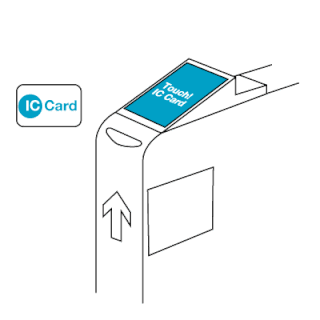
The EZ-Link card is a rechargeable contactless smart card and electronic money system that is primarily used as a payment method for public transport such as bus and rail lines in Singapore. A standard EZ-Link card is a credit-card-sized stored-value contact-less smart-card that comes in a variety of colours, as well as limited edition designs. It is sold by TransitLink Pte Ltd, a subsidiary of the Land Transport Authority (LTA), and can be used on travel modes across Singapore, including the Mass Rapid Transit (MRT), the Light Rail Transit (LRT), public buses which are operated by SBS Transit, SMRT Buses, Tower Transit Singapore and Go-Ahead Singapore, as well as the Sentosa Express.
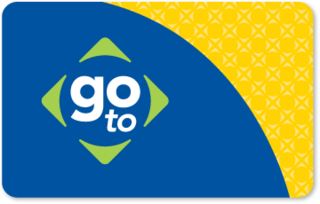
The Go-To card is a contactless smart card used to pay fares for bus, light rail, and commuter rail lines operated by Metro Transit and other transit agencies in the Twin Cities area of Minnesota. The system has significantly sped up boardings on area buses while alleviating wear and tear on existing ticket machines and fare boxes. The old magnetic strip reading machines were weather sensitive and could not be placed out in the elements like at the Hiawatha Line light rail stations.

The Edmonton Transit Service (ETS) is the public transit service owned and operated by the City of Edmonton in Alberta, Canada. It operates Edmonton's bus and light rail systems. In 2022, the system had a ridership of 68,829,300, or about 264,700 per weekday as of the third quarter of 2023.

MiWay, also known as Mississauga Transit and originally as Mississauga Transit Systems, is the municipal public transport agency serving Mississauga, Ontario, Canada, and is responsible to the city's Transportation and Works Department. MiWay services consist of two types of bus routes: MiLocal, local buses that make frequent stops, and MiExpress, express buses between major destinations. MiWay is the primary operator along the Mississauga Transitway, a dedicated east–west bus-only roadway.
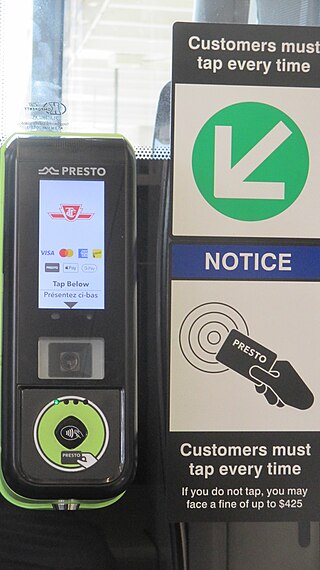
Fares to use the Toronto Transit Commission (TTC) transit system in Toronto, Ontario, Canada, can be paid with various media. The price of fares varies according to age, occupation, income level, and health condition of riders.

The Clipper card is a reloadable contactless smart card used for automated fare collection in the San Francisco Bay Area. First introduced as TransLink in 2002 by the Metropolitan Transportation Commission (MTC) as a pilot program, it was rebranded in its current form on June 16, 2010. Like other transit smart cards such as the Oyster card, the Clipper card is a credit card-sized stored-value card capable of holding both cash value and transit passes for the participating transit agencies. In addition to the traditional plastic card, Clipper is available as a virtual card in Google Wallet and Apple Wallet. Clipper is accepted by nearly all public transit services in the Bay Area, including but not limited to Muni, BART, Caltrain, AC Transit, SamTrans, Golden Gate Transit, Golden Gate Ferry, San Francisco Bay Ferry, and VTA.

The Presto card is a contactless smart card automated fare collection system used on participating public transit systems in the province of Ontario, Canada, specifically in Greater Toronto, Hamilton, and Ottawa. Presto card readers were implemented on a trial basis from 25 June 2007 to 30 September 2008. Full implementation began in November 2009 and it was rolled out across rapid transit stations, railway stations, bus stops and terminals, and transit vehicles on eleven different transit systems.

Rail operators are government-assisted profit-based corporations, fares and ticketing on Singapore's Mass Rapid Transit (MRT) system are aimed to break-even or exceed operating expenses. Rail operators collect fares based on account-based (ABT) and card-based ticketing options, the prices of which are calculated based on the distances travelled between the origin and destination. These prices increase in stages for standard non-concessionary travel, according to the distances travelled. In account-based ticketing, the fare is automatically calculated in the back-end and charged to the passenger post journey. On the other hand, card-based ticketing is proprietary to the transport network and the fare is computed by the system based on the store values recorded in the cards. The public transit system is harmonising towards full ABT.

Edmonton Light Rail Transit, commonly referred to as the LRT, is a light rail system in Edmonton, Alberta. Part of the Edmonton Transit Service (ETS), the system has 29 stations on three lines and 37.4 km (23.2 mi) of track. As of 2018, it was number seven on a list of the busiest light rail transit systems in North America, with over 113,000 daily weekday riders.

SmartLink is a RFID-enabled credit card-sized smartcard that is the primary fare payment method on the PATH transit system in Newark and Hudson County in New Jersey and Manhattan in New York City. It was designed to replace PATH's paper-based farecard, QuickCard, and there was plans to expand its usage throughout most transit agencies in the tri-state area. The SmartLink card has been available to the public since July 2, 2007. Although the MetroCard used on the Metropolitan Transportation Authority (MTA)'s transit system can also be used on the PATH, the reverse is not true for SmartLink, which cannot be used on the MTA's system.

The ORCA card is a contactless, stored-value smart card system for public transit in the Puget Sound region of Washington, United States. The card is valid on most transit systems in the Seattle metropolitan area, including Sound Transit, local bus agencies, Washington State Ferries, the King County Water Taxi, and Kitsap Fast Ferries. It was launched in 2009 and is managed by the Central Puget Sound Regional Fare Coordination Project, a board composed of local transit agencies.

The Transit Access Pass (TAP) is a contactless smart card used for automated fare collection on most public transport agencies within Los Angeles County, California. The card is also available in electronic form, free of charge, in Apple Wallet, thereby bypassing the need to purchase the plastic USD $2 card. It is administered by the Los Angeles County Metropolitan Transportation Authority (Metro), and the card and fare collection systems are manufactured by Cubic Transportation Systems.
GO Transit is the inter-regional transportation authority of the Golden Horseshoe, which includes the Greater Toronto and Hamilton Area. It is Canada's oldest regional transit system, first serving passengers in 1967.

The Compass card is a contactless smart card automated fare collection system used primarily for public transit in Metro Vancouver, British Columbia, Canada. Compass card readers were first implemented as a beta in September 2013. Due to delays, full implementation to the general public began in August 2015. The system is operated by Cubic Transportation Systems and is managed by TransLink, the transportation authority for the region.
A reduced fare program refers to special programs providing particular passengers with a discounted fare option for travel on a public transport system. In the United States, public transportation systems that receive federal funding are required to offer, at minimum, half fares to the elderly and handicapped persons during off peak travel. Some transportation systems also extend reduced fare options to youth, students, military personnel, and low-income passengers.
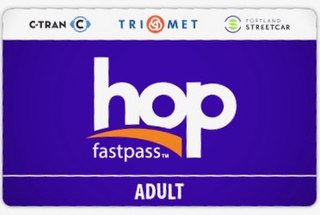
Hop Fastpass is a contactless smart card for public transit fare payment on most transit modes in the Portland, Oregon, metropolitan area including MAX Light Rail, WES commuter rail, Portland Streetcar, The Vine, and all TriMet and C-TRAN buses. An initial release to the general public began on July 5, 2017, with the official launch on July 17. The program is managed by TriMet.
OMNY is a contactless fare payment system, currently being implemented for use on public transit in the New York metropolitan area. OMNY can currently be used to pay fares at all New York City Subway and Staten Island Railway stations, on all MTA buses, AirTrain JFK, Metro North's Hudson Rail Link, and on the Roosevelt Island Tram; when completely rolled out, it will also replace the MetroCard on Bee-Line buses, and NICE buses. OMNY will also expand beyond the current scope of the MetroCard to include the Long Island Rail Road and Metro-North Railroad.
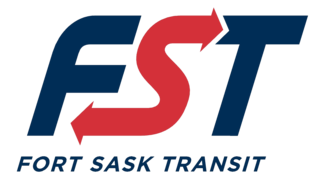
Fort Sask Transit (FST) is a public transit service in the city of Fort Saskatchewan, Alberta. It operates two routes within the city, and a third route is contracted to Edmonton Transit Service (ETS) to connect with its service network.

Pronto, stylized as PRONTO, is the second-generation contactless payment system for automated fare collection on public transit services in San Diego County, California. The system is managed by the San Diego Metropolitan Transit System, operated by INIT Systems, and is valid on all services operated by the Metropolitan Transit System, and on North County Transit District. It launched on September 1, 2021, replacing the first-generation Compass Card system. Pronto involved the installation of new fare machines at all transit stations. It was the first contactless smart card introduction in California during the COVID-19 pandemic.


















